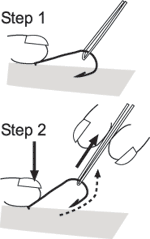

When jigging, tie on a salt-water fly or soft plastic bait above the jig, using a dropper loop. Some theorise that fish are competitive and the jig looks like a fish chasing a smaller bait fish and dart in to steal the food.
Tying good knots is a skill all fishermen must master if they are to be successful in catching fish. Two factors are important in tying good secure knots. The first is practice, and plenty of it. The second is finding a good knot guide on the internet to learn how to tie the various knots needed when fishing.
My favourite knot is the 'Uni knot'. It is easy to tie, holds firmly, and can be used for a number of tying purposes.
Practice is something we cannot help you with, but the more you practice the better your knots will be.
This next tip has no scientific basis that I know of. But what I do know, and my view is shared by more than a few good and great fishermen, is that using pink balloons to hold up a live bait seems to attract more yellowtail kingfish to the bait.
When using a balloon as a live bait float remember to tie the balloon off to the rod end of the swivel. If you tie it off to the bait end you can almost guarantee leader line twist and tangles.
When rigging up hapuku droppers get hold of some lumo tubing and thread the dropper loop through the lumo tube before tying on the hook.
The lumo tube adds some light down in the dark depths, and it adds extra stiffness to the dropper loop to help stop the loop wrapping around the main line on the way down.
If John Dory is not the best eating fish in the ocean it must run a very close second.
A lazy way to catch these wonderful fish is to impale a small bait fish on a hook, on a loop above a sinker or jig, and lower the rig to the bottom and then wind up a few turns to hold the bait above the bottom.
Leave the rod in the holder, and wait for dinner. Doing the same thing with a soft plastic bait fish will often do the trick just as well.
I got into some hot snapper fishing up at the Bay of Islands NZ recently. I caught a couple of good fish and despite the fact that the leader had taken a bit of a hiding, 'buck fever' took over and after the second fish I hooked up another big bait and fired it out.
Almost immediately something grabbed it and took off.
After a few minutes I could see a big (very!) snapper in the crystal clear water below the boat. The rod bucked and I watched the snapper bolt for the bottom.
Unfortunately it bolted away without any hindrance from me or my gear. Winding in I found the leader had broken not far above where the hook would have been.
Silly boy! For the sake of a few seconds to renew the leader I lost a very big fish. Yet again that old adage, little things mean a lot, bounced back to haunt me.
The best way of detecting a sticky drag is to put the reel on a rod, thread the line through the guides and have a friend, partner, child or Husky, pull off line while walking briskly away. Hold the rod at about 45 degrees.
If the rod tip ‘nods’ up and down as line is pulled off against the drag, you’ve got a problem.
Fortunately a sticky drag is easily fixed by a quick trip to the tackle shop.
Cracked guides are hard to see, but they can do some real damage to your line, and cost you fish. Usually cracked guides are only revealed when the rod is under load.
The easiest way to discover cracked guides is to pull a stocking or piece of cotton wool through the guides. Even better is to get someone to pull down on the rod tip, and then pull the stocking through the guides. Again, cracked guides are a reasonably quick fix at your tackle shop.
Sometimes trying to separate the joins on two (or more) piece rods can be an exercise in frustration, the joint just does not seem to want to come apart.
I do not know how or why this works, but put the rod behind your back and pull the joint apart - works most times.

Article written by Tony Bishop
How to remove a fishing hook from a human, painlessly and safely

Using this hook removal method, there is one common factor - the almost complete, and surprising, lack of any pain.
This method avoids the problems and pain that can be caused by some of the newer videos on hook removal.
When fishing, one mistake can be enough to kill you

Danger on the water can creep up on you, unnoticed, till too late.
I was lucky, very lucky. Much more lucky than I deserved to be. I broke too many rules.
